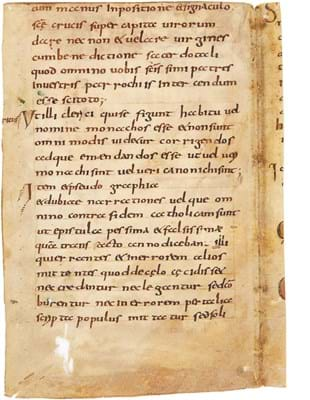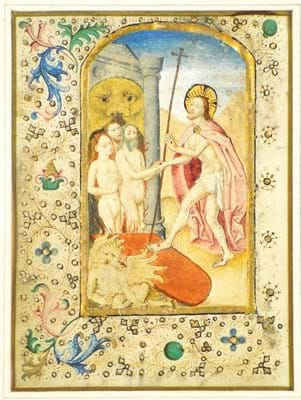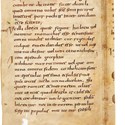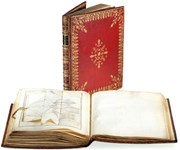One such find, sold for £36,000, was the first item to be offered in a 175-lot, July 6 sale of Western and Oriental manuscripts and miniatures held by Dreweatts & Bloomsbury (18/12% buyer’s premium).
The leaf, illustrated above, was removed from the binding of a 1489, Antwerp edition of Petrarch’s Decretum de contemptu mundi, and it features part of Charlemagne’s Admonitio Generalis, the law codes issued by the royal Frankish court in 789.
More significantly, it dates either from the lifetime of Charlemagne himself, or from the decades immediately following his death in 814. Carolingian law, the cataloguer pointed out, was founded on capitularies – documents recording the decisions of the royal court that were distributed throughout the provinces.
This work included an order for monasteries and cathedrals to set up schools to teach young boys grammar, church-song and the psalms in order to further the depth of Latin understanding and Christian beliefs throughout Frankish-controlled Europe. Other more practical subjects such as arithmetic, ratios, taxes, measures, agriculture and geometry were also to be taught.
All roads lead to Rome
Billed as quite possibly “the only manuscript copy to come to the market since records began” and sold at £42,000 was a Renaissance copy of the famous Antonine Itinerary.
This was a 2nd or 3rd century AD work, apparently based on official records, which detailed the extent of the Roman Empire and provided a register of the stations and distances between safe stopping places along its major roads.
Originally intended for army use, such ‘maps’ became common in the empire, even finding their place in public libraries, where they were intended to be used as practical travel guides.
The letters MP, for millia passum, that appear next to each place name along the respective routes are followed by a number indicating just how many Roman miles separate each location.
Dating from c.1500, the Bloomsbury manuscript of 136 leaves, which also incorporates similar forms of word-map dealing with Mediterranean sea routes and, more specifically, the route from Arles to Nimes, is thought to have been copied in either Italy or Spain from an earlier manuscript exemplar.
The Bloomsbury auction’s best-selling lot, at £55,000, was a 15th century Greek text compendium of canon law, homilies and other religious treatises. Written in part in Italy (perhaps Venice) by a Greek scribe, it was in a contemporary Greek style binding of dark goatskin by a Byzantine binder who was also working in Italy.
See also the amusing detail above from one of the drolleries of dragons and an array of other animals that decorate the illuminated borders of the ‘Hardouin Hours’, a Parisian parchment manuscript of the late 14th or early 15th century that sold for £23,000.
Italian works
A group of Venetian illuminated official documents and manuscripts, many issued under the aegis of various Doges of Venice, was offered as part of a Christie’s (25/20/12% buyer’s premium) sale of July 12.
On the day, a top price of £38,000 secured one of the items illustrated in a preview that can be found online at antiquestradegazette.com – a beautifully illuminated commissione of 1498 in which Doge Agostino Barbarigo appoints a certain Gabriele Barbarigo (a relation?) to the post of galley captain on an expedition to Beirut.

4. A leaf depicting the armorials of the compilers of a manuscript pharmacopeia sold for £16,000 by Christie’s.
Illustrated above, however, is a much later Venetian manuscript that sold for £16,000. Dated 1706, it comes from a pharmacopeia and manual relating to the training and examination of would-be pharmacists.
It is a compendium of some 160 recipes for the preparation of pills, syrups, oils and potions, among them one for Esdra, a treatment for inflammation of the stomach and for strangury (blockage or irritation of the bladder) that required the use of no fewer than 150 ingredients!
Three different pharmacists were tasked with producing the manual and their coats of arms are seen on the spread reproduced here.
See also the very large initial ‘B’ cut from a late 15th century Italian psalter (illustrated below) which sold for £60,000 at Christie’s.
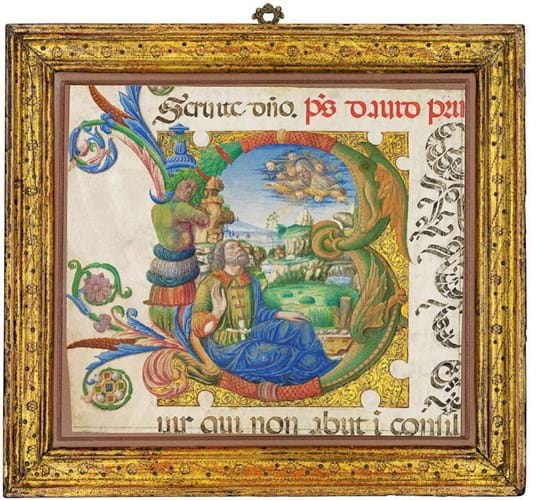
Cut from what must have been an extremely large psalter produced in Verona in the 1490s, this framed illuminated letter ‘B’, a little over 12in (31cm) wide, realised £60,000 at Christie’s on July 12. It is the work of Liberale da Verona, one of the great illuminators and fresco painters of the Italian renaissance.
Dutch prayerbook
The most expensive item in a 55-lot early manuscript selection offered as part of a May 23 sale held by Sotheby’s (25/20/12.5% buyer’s premium) was a Dutch language vellum prayerbook of c.1570-80.
Featuring very distinctive decorative borders to the 34 full-page miniatures, this was a lot reported and illustrated in ATG No 2302.
Two other notable manuscripts featured in the June 7 Sotheby’s sale of the William O’Brian library (see main report in ATG No 2297).
Sold for £38,000 was an unfinished, but up to that point complete vellum manuscript of Peter Lombard’s ‘Commentary on the Pauline Epistle’ that dates from the first half of the 13th century and had its origins in France, or perhaps the southern Netherlands. The binding of early 18th century polished calf was typical of those produced for the library of the Premonstratensian Abbey of Parc, near Leuven.
That library was sold in 1829 and this was among the many Parc manuscripts that found their way into the Hartwell House library of John Lee. He was a collector who in the Sotheby’s catalogue is neatly and intriguingly summed up as a “philanthropist, astronomer, mathematician, antiquarian, tomb-robber, barrister and teetotaller”.
Written in large part by Jacobus Siber for use at his own Augustinian abbey of St John the Baptist at Rebdorf in Bavaria, a late 15th century vellum manuscript of the ‘Treatises and Epistles’ of the writer known as the Pseudo Dionysius the Areopagite was sold for £75,000.
In the Latin translation of John Sarrazin and incorporating the glosses of Thomas Gallus, it had been acquired by O’Brian at an 1896 sale of one small part of the vast manuscript collection amassed by Sir Thomas Phillipps.


